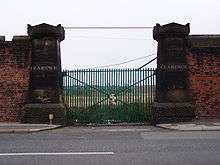Clarence Dock (Liverpool)
| Clarence Dock | |
|---|---|
 Clarence Dock entrance | |
| Location | |
| Location | Liverpool, United Kingdom |
| Coordinates | 53°25′09″N 3°00′07″W / 53.4191°N 3.0019°WCoordinates: 53°25′09″N 3°00′07″W / 53.4191°N 3.0019°W |
| OS grid | SJ334918 |
| Details | |
| Opened | 16 September 1830 |
| Closed | 1928[1] |
| Type | Wet dock |
| Area | 6 acres (2.4 ha), 273 sq yd (228 m2)[2] |
| Width at entrance | 47 ft (14 m)[3] |
| Quay length | 914 yd (836 m)[3] |
Clarence Dock was a dock on the River Mersey, England, and part of the Port of Liverpool. Situated in the northern dock system in Vauxhall, it was connected to Trafalgar Dock.
History
Designed by Jesse Hartley, the dock opened on 16 September 1830.[4] Clarence Dock was named after William, Duke of Clarence, who became William IV.[5]
It was built as a self-contained steamship dock facility.[1] This was to avoid the risk of fire to wooden-hulled sailing vessels then using the other docks.[5][6]
The dock was the berth for the Irish ferry ships. During the Irish famine in the 1840s over 1.3 million Irish people travelled through the dock. After many weeks or months, many took a took ship to America from Waterloo Dock, there being no direct sailings to America from Ireland. Others moved to London and other British towns and cities.[5]
The dock closed in 1928,[1] and was filled in 1929 when the site was used for a power station.[7] The three large chimneys of the Clarence Dock Power Station were a familiar local landmark, known as the Three Sisters,[8] until the power station was demolished in 1994.[1]
Present

The two Clarence Graving Docks are still extant and accessible via what remains of Trafalgar Dock.
As part of the Liverpool Waters development, Clarence Dock will become one of the clusters of tall buildings. It was one of the two clusters of tall high-rise buildings which have been agreed between Peel Holdings and English Heritage.
In 2004 it was proposed that a 60,000 seater stadium for Everton FC be built at Clarence Dock by the Mersey Docks & Harbour Company and the NWDA.[9][10] This would have included a rapid rail service to be financed by the NWDA.[11] Nothing became of this. However in 2016 the site re-emerged as one of two possible new locations for a new ground for Everton.[12]
References
- 1 2 3 4 Pollard & Pevsner 2006, p. 277
- ↑ Baines 1859, Part II, p. 91
- 1 2 Baines 1859, Part II, p. 116
- ↑ "The Clarence Dock". Old Liverpool / Picture of Liverpool: Strangers Guide. 1834. Archived from the original on 13 May 2008. Retrieved 10 April 2008.
- 1 2 3 "Clarence Dock Famine Memorial". irishseashipping.co.uk. Retrieved 10 April 2008.
- ↑ "Trading Places: A History of Liverpool Docks (Clarence Dock)". Liverpool Museums. Archived from the original on 28 October 2008. Retrieved 10 April 2008.
- ↑ "Clarence Dock". Liverpool History Online. Archived from the original on 16 January 2009.
- ↑ "Tagged: Overhead Railway". Streets of Liverpool. Retrieved 30 August 2016.
- ↑ Gleeson, Bill (12 June 2004). "New pressure for clubs to agree ground sharing; £10m at risk with deadline a month away.". Liverpool Daily Post. Retrieved 30 August 2016.
- ↑ http://www.nsno.co.uk/e107_images/newspost_images/plan1.jpg. Missing or empty
|title=(help) - ↑ http://www.nsno.co.uk/e107_images/newspost_images/plan2.jpg. Missing or empty
|title=(help) - ↑ Murphy, Liam (18 May 2016). "Images show vast scale of potential new Everton stadium site in Liverpool's docklands". Liverpool Echo. Retrieved 30 August 2016.
Sources
- Baines, Thomas (1859). Liverpool in 1859. London: Longman & Co. OCLC 43484994.
- Pollard, Richard; Pevsner, Nikolaus (2006). Lancashire: Liverpool and the South West. Yale University Press. ISBN 9780300109108. OCLC 63396571.
Further reading
- McCarron, Ken; Jarvis, Adrian (1992). Give a Dock a Good Name?. Birkenhead: Merseyside Port Folios. pp. 27–29. ISBN 9780951612941. OCLC 27770301.
External links
| Wikimedia Commons has media related to Clarence Dock. |
- "Liverpool North Docks diagram". Archived from the original on 8 January 2009.
- Site of Clarence Dock aerial photo
- Clarence Dock Power Station photo